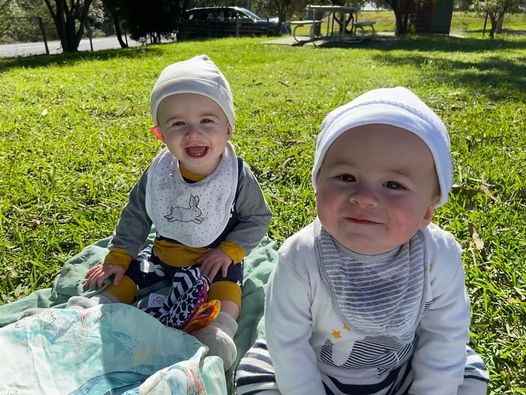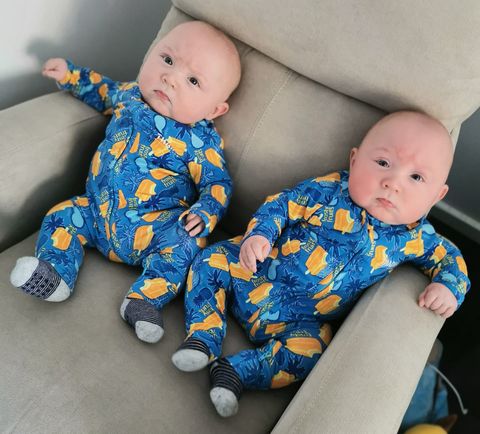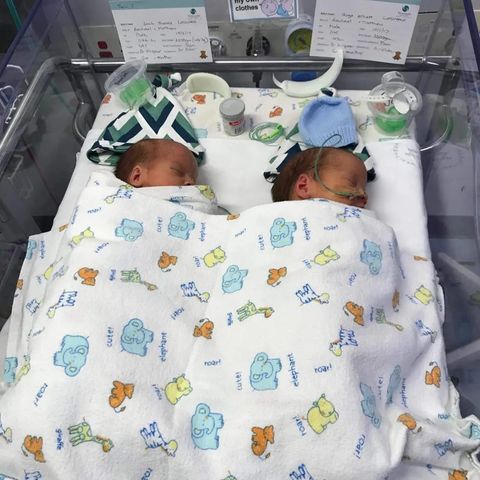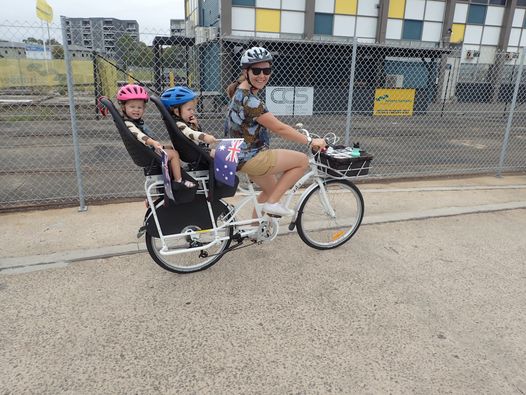Our History
In 2019, Newcastle Multiple Birth Club celebrated our 50th anniversary. On this occasion, Lyndy Booth, the founder of our club, took the opportunity to reflect on some key milestones and memories.
1970s
When our girls were babies, I read about the National Organisation of Mothers of Twins Clubs in the USA in the book Twins and Supertwins by Amram Scheinfeld (US twin researcher). I wrote to
the club who responded with encouragement to establish a similar club in Australia! Grev and I were friends with John Lewis (at that time the editor of the The Newcastle Sun and currently Newcastle Herald’s wine expert), who showed great interest in the idea, and as a result of the great publicity he arranged in the Sun, 17 mothers of twins (MOTs) got together as our foundation members. We represented many different family situations, and had twins of varying ages and twin types. I can’t remember all details about each one, but have done the best I can!
We based the way we operated and conducted meetings and produced our newsletter, on Grev’s and my Newcastle Apex Club connections (believe it or not, with our 3 toddlers, some of my diversional therapy was provided by typing that club’s minutes, as well as the stencils for its fortnightly newsletter, which was run off on a Gestetner black ink duplicator that lived in our garage!). Mona also contributed a lot of valuable input regarding meeting procedure and constitution from her years of experience involved with school P&Cs, Wallsend View Club, and her husband’s accountancy input. Over a number of years, many members commented how experience in our meetings proved invaluable as they became involved with infants school mothers’ club and P&Cs Early meetings were held in private homes of members. The first Christmas picnic was held at Speers Point Park, with a line of cloth nappies hanging near the shelter shed, so new families attracted by media publicity could find the group.
By March 1970 the monthly club meetings being held in the evening at Adamstown Preschool (the principal was a club member). Most of the chairs were only pre-schooler size, but that didn’t dampen our enthusiasm, and we had many excellent guest speakers, panels, some fun activities, and great suppers! Regular thrift sales of babies and children’s clothing were held, sometimes with items being donated and income being donated to club funds. Newsletter names voted on in August were Twincerely, Repetition and the final choice, Gemini News. We selected blue and gold as the club’s colours.
Wallsend Hospital children’s ward became the club’s first charity, being supported by donations of children’s clothing (pyjamas, nighties, booties, jumpers, matinee jackets, singlets – 2nd hand as well as brand-new items sewn by members). By July the club had two patrons, Matron Punton from Wallsend Hospital and Matron Devine from Newcastle Western Suburbs Maternity Hospital. With their encouragement, club members made regular visits to new multiple birth mothers while in hospital, with baby gifts donated by club members.
55 members participated in a club survey conducted in 1970: 51 had twins, 2 had two sets of twins, and 2 had triplets; average age of the mother when multiples were born was 27 years; by end of 1970, 76% of members had multiples under age 5; average diagnosis of multiple birth occurred at 32 weeks’ gestation.

Steelcraft’s newest twin-stroller model would fit through a normal doorway (no division but 2 mattresses), with a front handle and a twin shopping bag. On the social scene, regular 10-pin bowling mornings were being held at Mayfield Bowl (with free child-minding). As club numbers increased, with our club’s encouragement, many members who lived in the relevant area formed Lake Macquarie MOTC
Following the 1973 Sydney weekend get-together (the first convention!) of mainly NSW clubs, the possibility of individual state organisations or a national organisation of our clubs was investigated
In July 1974 the two local clubs hosted the second national convention at Belmont Sportsman’s Club, at which AMBA was officially formed. The Friday evening welcome was hosted by the Lake club at the home of Joan and Mal Grant at Valentine. The day outing was to the vineyards by bus (fare $1.30 per adult, 80c. per child), and the final social function was a barbecue at the home of foundation member and club President, Jeanette Muxlow.
In 1974 the club’s playgroup changed its name to Playday. Annual fees were now $5.00.
A group of us, including new club patron, Sister Juliana (Mater Hospital), travelled by coach to Melbourne that year for the 2nd national convention One of the session leaders was psychologist,
Val Newton-John (mother of singer, Olivia). One of her great ideas was to occasionally have a pyjama day at home – no-one changing out of their PJs, focusing on family time together, and if someone came to call, offering the explanation “It’s okay – we’re having a pyjama day!”

In mid-1975 Rae Reid was made the club’s 2nd Life Member (the same honour having been awarded to me two years prior). By then there were 27 multiple birth clubs in Australia. Several other clubs had been started by former club members who had moved away.
AMBA was conducting a survey of multiple birth children aged 6 months to 3 years. Blood-testing was the only reliable method for diagnosing twin type, so club members participated actively in an international survey to help determine twin zygosity. Local police helped train us in how to accurately take the required hand and foot prints, and a questionnaire was also completed about each set of multiples, with all information being sent to the USA.
Interim reports helped some members decide whether their multiples were identical or fraternal.

$1200.00 was raised at a 1976 benefit night, and was divided between Delando Crescent Special School and the two Hospital Schools at Royal Newcastle and the Mater.
Results of the Twin Similarity questionnaire (part of the hand-print/foot-print survey mentioned above) were received in 1977, classifying members’ multiples as high, mid or low identical, and
high, mid or low fraternal. Some aspects included face shape and features, hair and eye colouring, body structure, hand and foot shape, even ear-lobe shape. Having been told at their birth that my own girls were fraternal, I then learned they were mid identical, of which I now have no doubt.
Sadly, the researcher died before his study was completed, so we were disappointed that no further results were ever received.

The club’s evening meeting place moved the University Child Care Centre at Shortland in 1978.
The first club Recipe Book was produced. AMBA was initiating its Twin Registry, to assist with research.
By 1979 the club continued to run successful street cake stalls, and was selling car stickers and tshirt transfers (Twins Are Two-Beaut, One is Beaut Too and Triplets are Terrific). As part of its 10th anniversary, the club hosted the AMBA state seminar at Newcastle Uni.
Metal buggy clamps (for joining two single strollers together) could be bought from the State Resource centre. AMBA researcher, Pat Stewart (later OAM), was conducting, in conjunction with a University Medical professor, the Oral Contraceptive Study (initially revealing a correlation between post-pill pregnancies and multiple birth occurrences, and a further development which revealed possible association between initially investigated oral contraceptive usage and its effect on subsequent congenital abnormalities).
When our girls were babies, I read about the National Organisation of Mothers of Twins Clubs in the USA in the book Twins and Supertwins by Amram Scheinfeld (US twin researcher). I wrote to
the club who responded with encouragement to establish a similar club in Australia! Grev and I were friends with John Lewis (at that time the editor of the The Newcastle Sun and currently Newcastle Herald’s wine expert), who showed great interest in the idea, and as a result of the great publicity he arranged in the Sun, 17 mothers of twins (MOTs) got together as our foundation members. We represented many different family situations, and had twins of varying ages and twin types. I can’t remember all details about each one, but have done the best I can!
We based the way we operated and conducted meetings and produced our newsletter, on Grev’s and my Newcastle Apex Club connections (believe it or not, with our 3 toddlers, some of my diversional therapy was provided by typing that club’s minutes, as well as the stencils for its fortnightly newsletter, which was run off on a Gestetner black ink duplicator that lived in our garage!). Mona also contributed a lot of valuable input regarding meeting procedure and constitution from her years of experience involved with school P&Cs, Wallsend View Club, and her husband’s accountancy input. Over a number of years, many members commented how experience in our meetings proved invaluable as they became involved with infants school mothers’ club and P&Cs Early meetings were held in private homes of members. The first Christmas picnic was held at Speers Point Park, with a line of cloth nappies hanging near the shelter shed, so new families attracted by media publicity could find the group.
In July 1974 the two local clubs hosted the second national convention at Belmont Sportsman’s Club, at which AMBA was officially formed. The Friday evening welcome was hosted by the Lake club at the home of Joan and Mal Grant at Valentine. The day outing was to the vineyards by bus (fare $1.30 per adult, 80c. per child), and the final social function was a barbecue at the home of foundation member and club President, Jeanette Muxlow.
In mid-1975 Rae Reid was made the club’s 2nd Life Member (the same honour having been awarded to me two years prior). By then there were 27 multiple birth clubs in Australia. Several other clubs had been started by former club members who had moved away.
AMBA was conducting a survey of multiple birth children aged 6 months to 3 years. Blood-testing was the only reliable method for diagnosing twin type, so club members participated actively in an international survey to help determine twin zygosity. Local police helped train us in how to accurately take the required hand and foot prints, and a questionnaire was also completed about each set of multiples, with all information being sent to the USA.
Interim reports helped some members decide whether their multiples were identical or fraternal.
By 1979 the club continued to run successful street cake stalls, and was selling car stickers and tshirt transfers (Twins Are Two-Beaut, One is Beaut Too and Triplets are Terrific). As part of its 10th anniversary, the club hosted the AMBA state seminar at Newcastle Uni.
Metal buggy clamps (for joining two single strollers together) could be bought from the State Resource centre. AMBA researcher, Pat Stewart (later OAM), was conducting, in conjunction with a University Medical professor, the Oral Contraceptive Study (initially revealing a correlation between post-pill pregnancies and multiple birth occurrences, and a further development which revealed possible association between initially investigated oral contraceptive usage and its effect on subsequent congenital abnormalities).
During 1980 AMBA was conducting a survey prior to producing a helpful leaflet for multiple birth fathers. Club regular craft sessions were being held. Late in the year, the club meeting venue changed to the Community Health Centre, Newcastle West AMBA’s Twin Registry represented 12,000 pairs of twins of all ages living all over Australia by 1981. Issues of interest in the next few years were the possibility of insuring against having a multiple birth, Australia’s first successfully-separated Siamese twins (occurring 18 hours after their birth), and a new multiple birth diagnostic “tool”, the obstetric ultrasound.
Newcastle Mothers of Twins Club Inc. became the new club name in 1987. Boomerang pillows (to assist with twin breastfeeding) were donated to the Mater and Western Suburbs Maternity hospitals. The club was conducting a pram and stroller survey. The 15th AMBA convention was held on the Gold Coast.
In 1992 AMBA began producing its Triplet Newsletter, and also a bereavement leaflet, along with re-writing its booklet, 1-2-3 Help for triplet parents. A talk package with OHP transparencies was
available for members to use when addressing school and other organisations, along with a new Twins in School booklet. The club continually updated its own Expo session “visual aid” entitled Pair Care, a collection of photos covering many aspects of pregnancy, birth and coping afterwards in hospital and at home.
Following action by the club, supported by AMBA, twin shopping trolleys had started to become available at major supermarkets, but were becoming so popular among parents with non-twins, that centre management needed to be approached to ensure availability for multiple birth families. Families whose multiples had been born pre-term at one hospital, then transferred to another hospital prior to hospital discharge, were being encouraged to contribute towards a booklet being prepared by the NSW Pregnancy and Newborn Services Network.
In 2001 the club received AMBA approval for its proposed new webpage, which was up and running by September. New club patrons were Drs. Rachel Glover and Phil Buckner. There were now three toddlers groups (1-2 years, 2-3 years, and 3 & over). Results of a club survey early that year revealed the club library and coffee mornings were the club’s most popular and useful aspects; AMBA state seminars and conventions were not high priorities among members, mainly because life was too busy, and conventions were too expensive; also, financial sponsorship of the club’s state seminar delegates was supported, while that of national convention delegates was not. Most popular recommended use for surplus club funds was to purchase library books and videos, as well as breast pumps for the Equipment Service.
In 2007 club fees increased to $40.00. Fund-raising events were Family Portraits, Total Learning Book Look, a Mother’s Day raffle, Entertainment Books, and a Christmas raffle. To celebrate the club’s 38th birthday a sausage sizzle and market day were held at Jesmond Neighbourhood Centre. The office of club President was vacant for 12 months from August, and the other officers took turns at chairing the Board meetings, and modified the club constitution to cover the situation. In November the club hosted the 35th AMBA national convention at the Crowne Plaza Hotel, during which special club awards recognising outstanding services, were made to Kim Brennan, Jen Lissarrague and Liz Young.
Following two successful years, the club’s Port Stephens morning tea group co-ordinated by Belinda Kirkegard, held its final get-together in 2010. The West Lake Macquarie and Central Coast groups were still functioning, along with the local Babies and Non-Walkers, Toddlers and All-Ages groups. Mid-year, a Trivia Night fund-raiser was held at Club Macquarie, Argenton. Club fees could now be paid by EFT. A special donation was made to John Hunter Children’s Hospital in recognition of ongoing care for premature babies. The School Readiness program had been running annually for many years by now, and was always a popular night. Triplet mum, Liz Young became Life Member number 10 in August. Marion Gevers held the role of LOTE (Languages other than English) for AMBA, a very new service to support relevant multiple birth families in Australia.
By 2012 Tamworth Club ceased to operate, so membership was offered to multiple birth families in the New England region. The club was upset to learn of a Queensland multiple birth family who’d lost everything in horrendous storms a year earlier, followed by their newly-renovated home being destroyed by fire, and was happy to be in a position to donate two vouchers (accommodation and Wet’n’Wild entry) to give the family a treat.
As the club entered its 50th year, a celebratory get-together was held in March 2019 at the Beaches Hotel in Merewether. That same
month saw the last printed issue of Gemini News. Future issues will be e-versions – a bit of a problem for some of the older members of the club who may not have easy access to a computer, but a wise move, given the high cost of paper, printing and postage.
Since 2019, volunteers have worked tirelessly to connect and support families in the broader Hunter region. 2020 (and 2021) was a major challenge for us in facing Covid19 and the pandemic, and forced us to think on our feet and pivot the way we offered some support. Thanks to a grant from Newcastle City Council, we were able to have food hampers delivered to some of our families with multiples under 5 during this time of struggle. We also moved to hosting our expectancy sessions online, which has been a great relief to many heavily pregnant attendees.
Through 2022 and 2023, we have been able to get back on track with a supportive and dedicated team of volunteers, and have been featured in local media for several good news stories, including 12 sets of twins and 1 set of triplets starting school, and our awesome 2023 Christmas party.